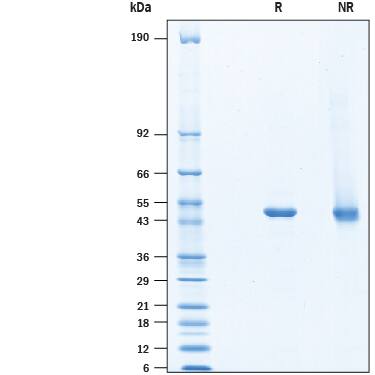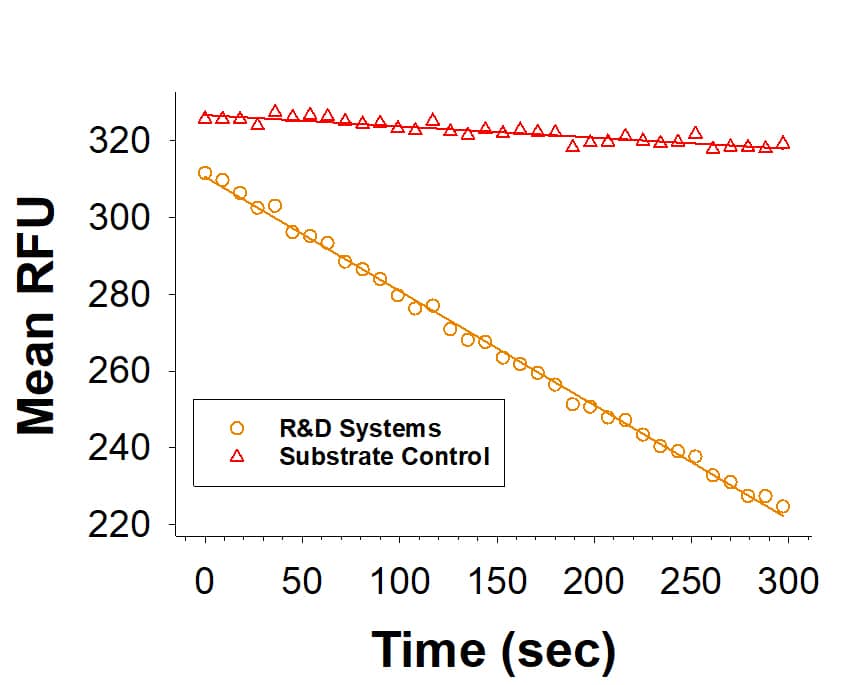Recombinant Human ODC1 His-tag Protein, CF
R&D Systems, part of Bio-Techne | Catalog # 10316-OD

Key Product Details
Product Specifications
Source
E. coli-derived human ODC1 protein
Asn2-Val461
with an N-terminal Met and 6-His tag
Asn2-Val461
with an N-terminal Met and 6-His tag
Purity
>95%, by SDS-PAGE visualized with Silver Staining and quantitative densitometry by Coomassie® Blue Staining.
Endotoxin Level
<0.10 EU per 1 μg of the protein by the LAL method.
N-terminal Sequence Analysis
Met
Predicted Molecular Mass
52 kDa
SDS-PAGE
49 kDa, under reducing conditions
Activity
Measured by its ability to convert ornithine to putrescine.
The specific activity is >750 pmol/min/μg, as measured under the described conditions.
The specific activity is >750 pmol/min/μg, as measured under the described conditions.
Scientific Data Images for Recombinant Human ODC1 His-tag Protein, CF
Recombinant Human ODC1 His-tag Protein Enzyme Activity
Recombinant Human ODC1 His-tag Protein (Catalog # 10316-OD) is measured by its ability to convert ornithine to putrescine.Recombinant Human ODC1 His-tag Protein SDS-PAGE
2 μg/lane of Recombinant Human ODC1 His-tag (Catalog # 10316-OD) was resolved with SDS-PAGE under reducing (R) and non-reducing (NR) conditions and visualized by Coomassie® Blue staining, showing a band at 49 kDa under reducing conditions.Formulation, Preparation and Storage
10316-OD
| Formulation | Supplied as a 0.2 μm filtered solution in Tris, NaCl and TCEP. |
| Shipping | The product is shipped with dry ice or equivalent. Upon receipt, store it immediately at the temperature recommended below. |
| Stability & Storage | Use a manual defrost freezer and avoid repeated freeze-thaw cycles.
|
Background: ODC1
References
- Bae, D. H. et al. (2018) Biochem. Biophys. Acta. Gen. Subj.1862:2053.
- Wu, H. Y. et al. (2015) PNAS 112:11229.
- Liu, Y. C. et al. (2011) PLoS One 11:e26835.
- Latour, Y. L. et al. (2019) Amino Acids [epub ahead of print] (PMID 31016375).
- Sivashanmugam, M. et al. (2017) Biomed. Pharmacother. 86:185.
- Pegg, A. E. (2006) J. Biol. Chem. 281:14529.
- Bachmann, A. S. and D. Geerts. (2018) J. Biol. Chem. 293:18757.
- Tabib, A. et al. (1994) Biochem. Biophys. Res. Commun. 202:720.
- Bupp, C. P. et al. (2018) Am. J. Med. Genet. 176:2548.
- Saletta, F. et al. (2010) Mol. Pharmacol. 77:443.
- Weicht, R.R. et al. (2018) Med. Sci. (Basel) 6: E65.
- Fattahi, S. et al. (2018) Cell Mol. Biol. 64:97.
- Lam, S.K. et al. (2018) Oncol. Rep. 40:1994.
- Ye, Z. et al. (2019) Onco. Targets Ther. 12:4081.
- Kim, H.I. et al. (2017) PLoS One. 12:e0189044.
Long Name
Ornithine Decarboxylase 1
Alternate Names
ODC
Gene Symbol
ODC1
UniProt
Additional ODC1 Products
Product Documents for Recombinant Human ODC1 His-tag Protein, CF
Product Specific Notices for Recombinant Human ODC1 His-tag Protein, CF
For research use only
